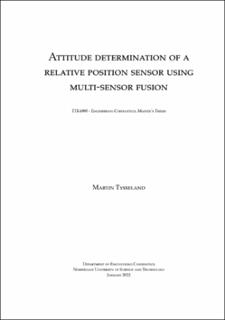| dc.contributor.advisor | Håland Bryne, Torleiv | |
| dc.contributor.author | Tysseland, Martin | |
| dc.date.accessioned | 2022-07-05T17:22:09Z | |
| dc.date.available | 2022-07-05T17:22:09Z | |
| dc.date.issued | 2022 | |
| dc.identifier | no.ntnu:inspera:91918311:18536389 | |
| dc.identifier.uri | https://hdl.handle.net/11250/3002910 | |
| dc.description.abstract | Denne masteroppgaven gir en innsikt i hvordan man kan bestemme orientering av et kretskort montert på et stativ. Målinger fra et 9-akse IMU og GNSS er brukt. Dette er kombinert med et ESKF for å estimere orienteringen i Euler-vinklene rull, tilt og himmelretning. Resultatene viser nøyaktighet for himmelretning med relativ posisjon fra to GNSS-antenner. De viser også forskjellen i himmelretning når magnetometer og GNSS brukes for korreksjon. Det viser seg at GNSS korreksjon fungerer bra når man har gyldig signal, og korreksjon med hjelp av magnetometer krever veldig god kalibrering for å være brukbar, men er fortsatt utsatt for magnetiske forstyrrelser. | |
| dc.description.abstract | This master's thesis contains insight into how to determinant the attitude of a circuit board mounted on a rig. Measurements from 9-axes IMU and GNSS are used, combined with ESKF to estimate the attitude in the Euler angles roll, pitch and yaw. The results shows accuracy from heading correction with relative position from two GNSS antennas, correction with magnetometer measurements and the difference between the solutions. The accelerometer is used to correct the roll and pitch. The GNSS correction works great when getting valid signals, and magnetometer correction needs good calibrating before being usable, and can still be victim of unwanted magnetic interference. | |
| dc.language | eng | |
| dc.publisher | NTNU | |
| dc.title | Attitude determination of a relative position sensor using multi-sensor fusion | |
| dc.type | Master thesis | |
